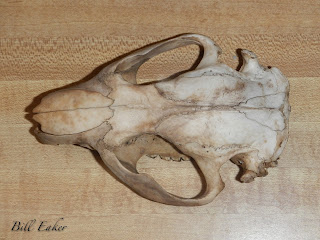I was out hiking the canal near Atkinson the other day and discovered an area that I had never seen activity in before. With foliage slowly disappearing, I saw a very wide path burrowing back into the thick brush like a small tank had barged through, and upon examination found a pretty nice sized tree that has been gnawed on pretty ferociously. I have yet to see a beaver actually doing this.
Not far down the path, I noticed a newly built beaver lodge in a depression along the bank. Beavers use wood, rocks, and mud to build their dens. They have at least two underwater entrances. Sticks are stored in their den due to the fact that once the ice covers the water, they do not exit their lodge very often, so the sticks become food throughout the winter. Beavers do not hibernate.
A good friend found a beaver skull a couple of weeks ago and asked if I wanted it! It's just like Christmas when I get little gifts such as these:) It is a very large skull in perfect shape. It really shows how robust a beaver's head is.
Other than the amazing, distinct tail, most people would probably think of the huge front incisors when discussing beaver. Beaver teeth grow continuously throughout their lives. The outer orange coating is hard, while the inside is softer. This creates a "self-sharpening" effect as they gnaw on wood. This, in turn, creates a chisel shape which allows for the amazing chewing power that they have. Beavers have 176 pound per-square-inch bite force!! Now it makes sense how they can get through the hardwood cores of certain types of trees. Below, you can see the outer hard enamel and the soft inner dentin in the chisel form.
The beaver's molars act as a file or rasp which helps them break down plant fibers and smaller twigs. These are certainly less intimidating than those incisors!
There are many beaver on the Hennepin canal and make for interesting learning opportunities if you stop to study their habitat. If you really want to see one, it would be best to find an area that has fresh sign, take a bright flashlight, and go out after dark. More than likely, you will be greeted by the startling slap of that magnificent tail on the water.








Nice! Skulls are the gift that keeps on giving! :)
ReplyDeleteIsn't that the truth! I love skulls and my collection is getting to a pretty decent size. I enjoy getting them out and looking at them, learning the parts of the skulls and looking for unique characteristics.
ReplyDeleteBill